Welcome to the Troy-Bilt TB110 Engine Manual, your comprehensive guide for safe operation, maintenance, and troubleshooting. This manual covers essential procedures for optimal performance and longevity.
Overview of the Troy-Bilt TB110 Engine
The Troy-Bilt TB110 engine is a reliable power unit designed for push mowers, models TB110 and TB130. It is engineered to deliver excellent performance when properly operated and maintained. The engine manual provides detailed guidance on safe operation practices, setup, and maintenance. It covers essential topics such as troubleshooting common issues, warranty information, and service procedures. The manual emphasizes proper usage to ensure longevity and optimal functionality. By following the instructions, users can maintain their engine effectively and address any problems promptly. This guide is a crucial resource for anyone seeking to understand and care for their Troy-Bilt TB110 engine.
Importance of the Engine Manual for Proper Operation
The Troy-Bilt TB110 engine manual is essential for ensuring safe and effective operation of your equipment. It provides detailed instructions for setup, maintenance, and troubleshooting, helping users avoid potential hazards. By following the manual, you can optimize engine performance, extend its lifespan, and prevent costly repairs. The guide also outlines proper usage practices, warranty terms, and service recommendations. Reading the manual thoroughly before operating the engine is crucial for understanding its functionality and addressing any issues promptly. It serves as a comprehensive resource for users, ensuring they can maintain and operate their Troy-Bilt TB110 engine with confidence and efficiency.
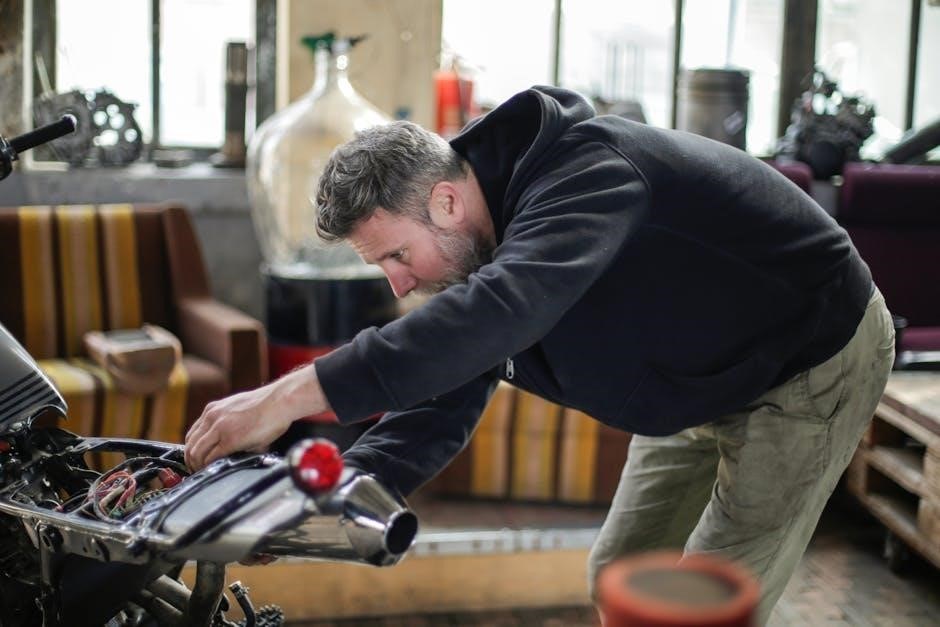
Key Features and Specifications of the Troy-Bilt TB110
The Troy-Bilt TB110 engine is a reliable, durable gas-powered unit, offering 11 HP of power. It ensures efficient performance for small to medium-duty applications while maintaining fuel efficiency, making it ideal for powering tillers, pressure washers, and other equipment.
Engine Power and Performance
The Troy-Bilt TB110 engine delivers reliable power with its 11 HP output, making it suitable for small to medium-duty applications. Designed for consistent performance, it features an overhead valve (OHV) configuration, which enhances fuel efficiency and reduces emissions. The engine’s robust design ensures smooth operation under various loads, making it ideal for powering equipment like tillers, generators, and pressure washers. With a focus on durability and efficiency, the TB110 engine is engineered to meet the demands of homeowners and professionals seeking dependable power for their tasks. Its balanced power delivery ensures optimal performance across a wide range of operating conditions.
Fuel Efficiency and Runtime
The Troy-Bilt TB110 engine is designed to provide excellent fuel efficiency, ensuring extended runtime during operation. With a 0.3-gallon fuel tank, the engine can operate for approximately 2 hours on a full tank, depending on workload and conditions. The engine’s overhead valve (OHV) technology contributes to improved fuel economy by minimizing energy loss and optimizing combustion efficiency. For optimal performance, it is recommended to use regular unleaded gasoline with an 87 octane rating or higher. Avoid using ethanol-blended fuels, as they may degrade fuel system components over time. Proper maintenance, such as regular oil changes and air filter cleaning, further enhances fuel efficiency and runtime.
- Avoid ethanol-blended fuels to prevent damage.
- Regular maintenance improves efficiency and runtime.
Design and Build Quality
The Troy-Bilt TB110 engine is constructed with durable materials, ensuring long-lasting performance and reliability. Its compact design features a sturdy steel frame, which provides excellent stability and protection against wear and tear. The engine’s overhead valve (OHV) technology not only enhances fuel efficiency but also contributes to a quieter operation. The build quality is robust, with components carefully engineered to withstand regular use and harsh outdoor conditions. The engine’s design emphasizes ease of maintenance, with accessible parts and a user-friendly layout. These factors make the TB110 a reliable choice for small to medium-sized tasks, delivering consistent power and durability over time.
- Durable steel frame for added stability.
- Compact design for easy handling and storage.
- Quieter operation due to OHV technology.
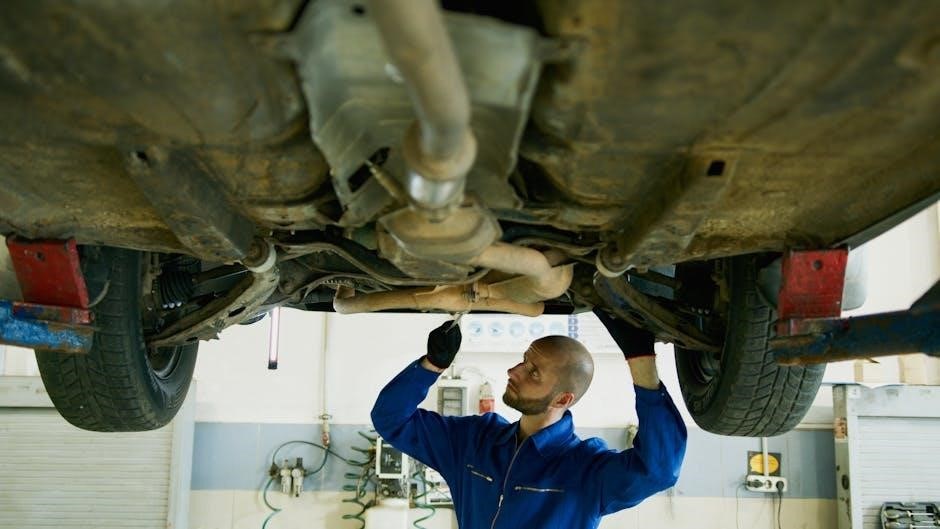
Safety Precautions and Operating Guidelines
Always adhere to safety guidelines when operating the Troy-Bilt TB110 engine. Wear protective gear, ensure proper handling, and maintain a safe working environment to minimize risks and hazards;
General Safety Tips for Engine Operation
Always ensure the area around the engine is clear of debris and flammable materials. Keep loose clothing and long hair tied back to avoid entanglement. Never operate the engine near open flames or sparks. Ensure proper ventilation to prevent carbon monoxide buildup. Avoid overreaching or stretching while handling the engine, as this can cause loss of control. Keep children and pets at a safe distance during operation. Familiarize yourself with emergency shutdown procedures. Never touch hot engine parts, as they can cause burns. Use the engine only for its intended purpose, as specified in the manual. Follow all safety guidelines to ensure safe and efficient operation.
Personal Protective Equipment (PPE) Recommendations
Always wear safety glasses or goggles to protect your eyes from debris. Use sturdy gloves to prevent cuts and abrasions when handling sharp or hot parts. A face mask is recommended to avoid inhaling dust or fumes during maintenance. Steel-toe boots or sturdy footwear can prevent injuries from heavy objects. Hearing protection, such as earplugs, is essential when operating the engine at high speeds. Ensure all PPE fits properly and is in good condition. Avoid loose jewelry or accessories that could get caught in moving parts. Wearing appropriate PPE minimizes risks and ensures a safer working environment while operating or servicing the Troy-Bilt TB110 engine.
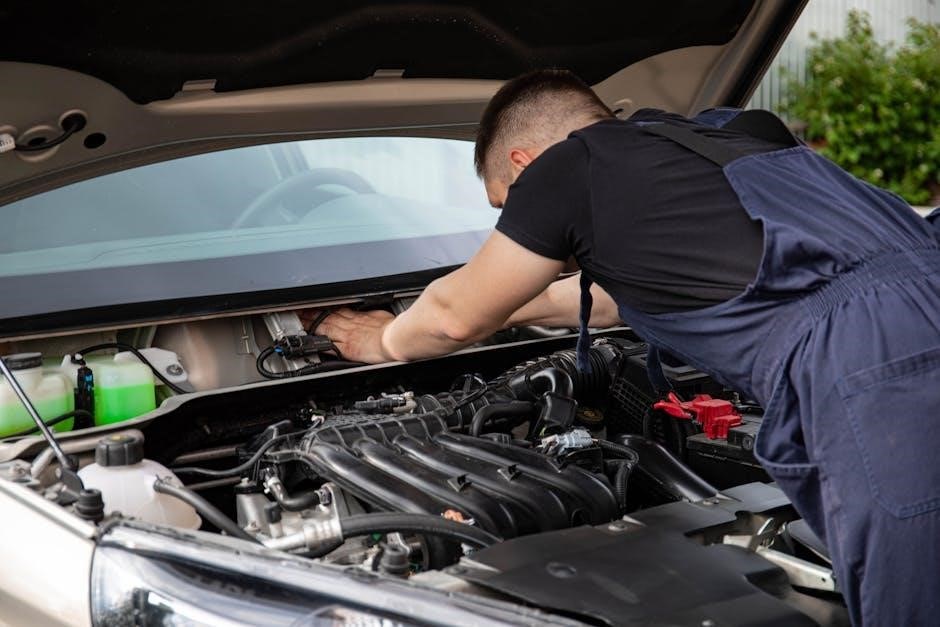
Assembly and Setup Instructions
Follow the step-by-step assembly guide to ensure proper setup. Begin with unpacking and inventorying all parts. Assemble components in the recommended sequence. Tighten all bolts securely.
Always adhere to safety guidelines during assembly to prevent accidents.
Unpacking and Inventory of Parts
Begin by carefully unpacking the Troy-Bilt TB110 engine from its shipping container. Inspect all components for damage or missing items. Use the provided parts list to verify completeness.
Ensure you have the engine block, air filter, muffler, spark plug, and all hardware. Cross-reference each item with the manual’s inventory checklist. If any parts are damaged or missing, contact Troy-Bilt customer support immediately. Clean any protective packaging residue from components before assembly. Avoid forcing parts together, as this may cause damage. Organize components in a logical order to streamline the assembly process. Refer to the manual for specific guidance on identifying and preparing each part.
Step-by-Step Assembly Process
Follow the Troy-Bilt TB110 engine manual’s detailed instructions for assembly. Start by attaching the handle and control panel, ensuring all bolts are tightened securely. Next, install the muffler and air filter, aligning them properly with the engine block. Connect the throttle cable to the carburetor, making sure it operates smoothly. Refer to the manual for torque specifications when tightening bolts. After assembling major components, perform a safety check for loose connections or blockages. Test the engine by pulling the starter cord gently, ensuring it turns over without resistance. If issues arise, consult the troubleshooting section or contact customer support for assistance. Always follow the manual’s guidance for a successful assembly.

Regular Maintenance and Servicing
Regular maintenance ensures optimal performance and longevity of the Troy-Bilt TB110 engine. Check and maintain all components, follow the service schedule, and refer to the manual for guidance.
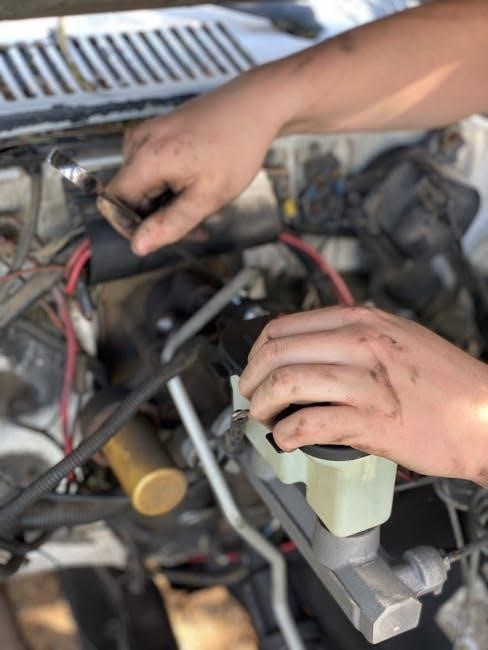
Oil Change and Lubrication Schedule
Regular oil changes are essential for maintaining the Troy-Bilt TB110 engine. Use SAE 30 oil for optimal performance. Change the oil every 20 hours of operation or at the start of each season. The engine requires approximately 20 ounces of oil. Always check the oil level before starting the engine to ensure proper lubrication; Consult the manual for the recommended oil type and viscosity to avoid damage. Lubricate moving parts periodically to reduce wear and tear. Synthetic oil is recommended for extreme temperatures. Follow the schedule to maintain engine health and performance. Refer to the manual for detailed instructions and guidelines. Regular lubrication ensures smooth operation and extends the engine’s lifespan.
Filter Cleaning and Replacement
Regular maintenance of the air and fuel filters in your Troy-Bilt TB110 engine is crucial for optimal performance. The air filter should be cleaned every 50 hours of operation or when visibly dirty. For a paper filter, replace it instead of cleaning. The fuel filter should be replaced every 100 hours or as needed. To clean the air filter, remove it, tap gently to remove debris, and wash with mild soap if reusable. Allow it to dry before reinstalling. For the fuel filter, turn off the engine, locate the filter, disconnect fuel lines carefully, and replace with a new one. Ensure tight connections to prevent leaks. Always use manufacturer-recommended filters to avoid engine damage. Work in a well-ventilated area when handling fuel filters to prevent fire hazards. Avoid using incorrect filters and ensure proper tightening to prevent leaks. Regular filter maintenance ensures clean airflow and fuel delivery, enhancing engine efficiency and lifespan.
Spark Plug Maintenance

Spark plug maintenance is essential for the Troy-Bilt TB110 engine to ensure proper ignition and performance. Replace the spark plug every 100 hours of operation or as needed. Before removal, disconnect the spark plug wire to prevent accidental engine start. Use a spark plug socket wrench to remove the plug. Inspect the electrode for wear or fouling. Clean or replace the spark plug if necessary. Check the electrode gap using a gap gauge and adjust to the recommended specification (typically 0.030 inches). Avoid over-tightening to prevent thread damage. Always use a spark plug of the correct type and rating specified in the manual; Proper maintenance ensures reliable engine ignition, efficient fuel combustion, and optimal performance. Keep spare spark plugs handy for quick replacements during routine servicing.

Troubleshooting Common Issues
Troubleshooting the Troy-Bilt TB110 engine involves identifying issues like poor performance or failure to start. Always check fuel levels, air filter cleanliness, and spark plug condition. Consult the manual for detailed diagnostic steps and solutions to ensure safe and effective repairs.
Diagnosing Engine Problems
Diagnosing issues with the Troy-Bilt TB110 engine requires a systematic approach. Start by identifying symptoms, such as rough running, lack of power, or failure to start. Check for common causes like faulty spark plugs, clogged air filters, or improper fuel levels. Use tools like a spark tester or multimeter to assess electrical components. Consult the manual for specific diagnostic procedures and troubleshooting charts. Pay attention to unusual noises, vibrations, or leaks, as these can indicate underlying problems. Always ensure the engine is cool and safe to work on before performing any inspections or repairs. Adhere to the manual’s guidelines to avoid further damage and ensure accurate diagnoses.
Common Faults and Solutions
The Troy-Bilt TB110 engine may encounter issues like failure to start, rough running, or overheating. A common fault is a clogged air filter, which can restrict airflow and reduce performance. Cleaning or replacing the air filter, as outlined in the manual, often resolves this. Another issue is improper fuel levels or stale fuel, which can cause starting difficulties. Draining old fuel and refilling with fresh gasoline typically fixes this. Spark plug problems, such as fouling or improper gapping, can also prevent engine operation. Cleaning or replacing the spark plug according to the manual’s specifications usually corrects this. Regular maintenance, as detailed in the manual, helps prevent these common faults and ensures reliable engine operation.
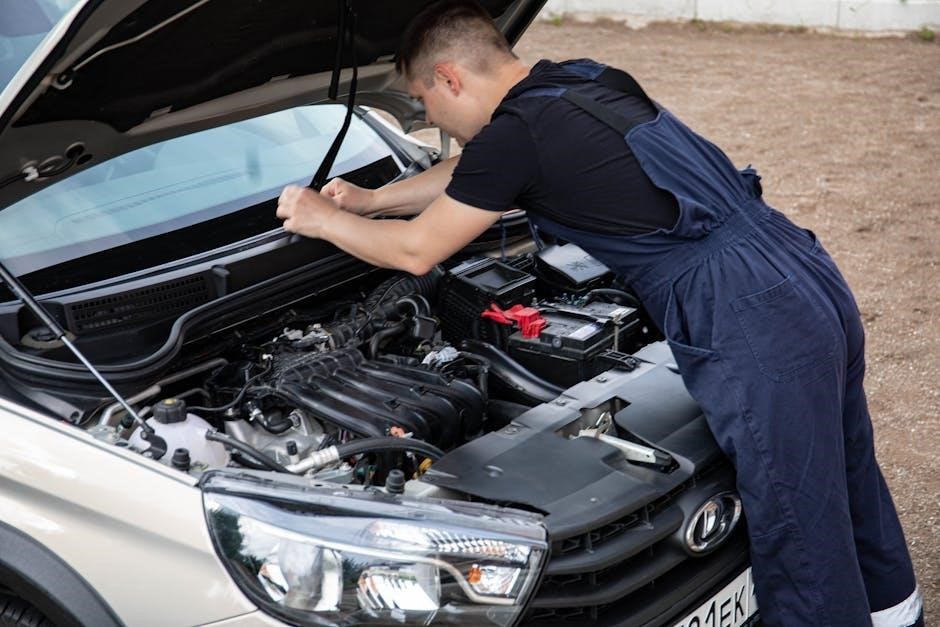
Warranty and Customer Support
The Troy-Bilt TB110 engine is backed by a limited warranty. For inquiries or claims, contact customer support via phone, email, or the official website.
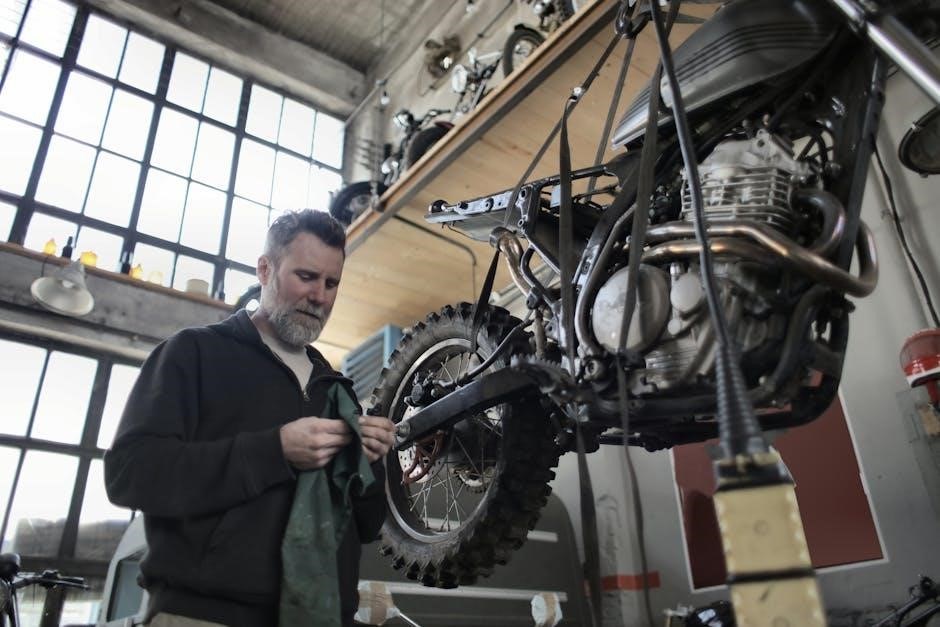
Understanding the Warranty Terms
The Troy-Bilt TB110 engine manual outlines a limited warranty program designed to protect your investment. The warranty typically covers manufacturing defects for a specified period, ensuring reliability and performance. It’s important to review the terms carefully, as certain conditions, such as improper use or unauthorized modifications, may void coverage; The warranty duration varies based on usage, with residential applications often receiving extended protection. For detailed information, refer to the manual’s warranty section, which provides guidelines on filing claims and resolving issues. Adhering to the warranty terms ensures optimal protection and support for your engine.
Contacting Troy-Bilt Customer Service
To address questions or concerns about the Troy-Bilt TB110 engine, customers can reach out to Troy-Bilt’s dedicated customer service team. The manual provides contact information, including phone numbers, email addresses, and website links. For immediate assistance, calling the customer support hotline is recommended. Additionally, users can visit the official Troy-Bilt website to access live chat support or submit a support ticket. The website also offers a comprehensive FAQ section and downloadable resources. Ensure to have the engine’s model number and serial number ready for faster service. Troy-Bilt’s customer service operates during specified business hours, and representatives are trained to assist with troubleshooting, warranty claims, and maintenance queries. Reaching out early helps resolve issues promptly.
Final Tips for Optimal Engine Performance
For optimal performance, ensure regular maintenance tasks are completed as outlined in the manual. Always check oil levels before use and maintain a clean air filter. Store fuel properly to avoid contamination and stale fuel issues. Keep the engine and surrounding areas clean to prevent debris buildup. Avoid overloading the engine beyond its recommended capacity. Follow the recommended spark plug replacement schedule for consistent ignition. By adhering to these guidelines, you can maximize efficiency, reduce wear and tear, and extend the lifespan of your Troy-Bilt TB110 engine. Consistent care will ensure reliable operation and peak performance over time.
Encouragement to Refer to the Manual Regularly
Referencing the Troy-Bilt TB110 engine manual regularly ensures you stay informed about best practices for operation, maintenance, and troubleshooting. The manual provides detailed guidance tailored to your engine, helping you avoid costly mistakes and prolong its lifespan. By reviewing the manual, you can identify potential issues early, ensuring safety and efficiency. It also serves as a quick reference for warranty information and customer support contacts. Regularly consulting the manual fosters a deeper understanding of your engine’s capabilities and maintenance needs, empowering you to achieve optimal performance and reliability. Make it a habit to revisit the manual periodically to stay updated and informed.
